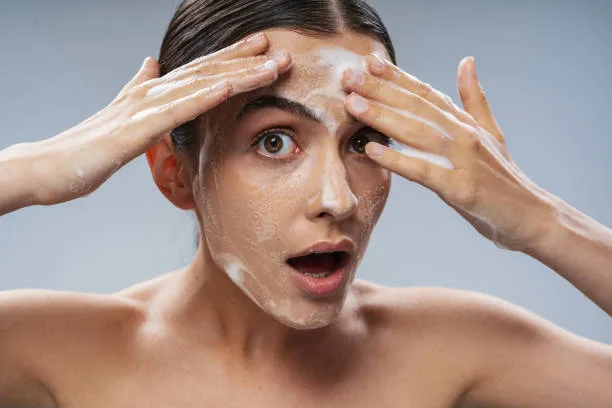Table of Contents
Introduction
Taking care of your skin is one of the best things you can do for your health and appearance. But knowing where to start can be overwhelming, especially if you’re new to skin care.

This beginner’s guide will walk you through the basics of building a simple, effective skin care routine from scratch. By starting with the fundamentals and adding products slowly over time, you’ll be on your way to healthy, glowing skin in no time.
Why Bother With a Skin Care Routine?

You may be wondering why it’s necessary to have a whole routine dedicated to caring for your skin. Can’t you just wash your face and be done with it?
While a basic cleanse is better than nothing, there are a few key reasons why following a complete routine is worth the small time investment each day:
- Prevents skin issues before they start – Consistent skincare keeps your skin barrier healthy. This means your skin will be better protected against damage that can lead to common issues like acne, wrinkles, and dryness.
- Manages existing skin conditions – If you already deal with breakouts, anti-ageing concerns, rosacea, eczema, or other skin conditions, a proper routine with ingredients that treat your specific needs will help control flare-ups and symptoms.
- Enhances natural radiance – Using exfoliants and moisturisers will slough off dull surface cells and hydrate your skin. This reveals the fresh, glowing skin underneath.
- It’s relaxing! – Following a nightly ritual can help you unwind before bed.
- Boosts confidence – When your skin looks its best, you’ll naturally feel more confident facing the day.
Where to Start: Skin Type and Concerns
Before buying any products, take some time to analyse your skin. Determining your skin type and skin concerns will help you build a routine with products that specifically address your skin’s needs. Here are the characteristics to consider:

Skin Type
There are five main skin types:
- Normal – Even texture, not overly oily or dry. Fine pores.
- Dry – Little oil production, flaky, itchy, redness, feels tight.
- Oily – Excess shine, large pores, acne-prone.
- Combination – Oily T-zone, dry cheeks.
- Sensitive – Easily irritated, redness, reacts to products.
If you’re unsure of your precise skin type, a dermatologist can analyse and classify your skin for you. But in general, neutral, non-irritating cleansers and lightweight moisturisers work well for combination and sensitive skin. Dry skin needs richer creams to restore moisture. And oily/acne-prone skin benefits from clarifying oil-control products.
Skin Concerns

Next, make note of any specific issues you want to improve. Some common skin concerns include:
- Acne – Whiteheads, blackheads, pimples from clogged pores.
- Ageing – Fine lines, wrinkles, age spots, uneven tone, loss of firmness.
- Dark spots – Discolouration, melasma from sun damage or hormones.
- Dullness – Lack of radiance, rough texture.
- Dehydration – Flakiness, tightness, dry patches.
- Redness – Rosacea, sensitivity, dilated capillaries.
Pick one or two pressing concerns to target first. You can expand your routine to tackle more issues over time. But especially as a beginner, it’s best to keep it simple and gentle at first.
Beginners Guide To Skin Care:
The Skin Care Basics: 4 Must-Have Steps

Now that you know your skin type and concerns, let’s cover the fundamental steps every basic routine needs. Consistently following these simple practices will visibly improve your complexion.
Cleanse AM and PM
Cleansing is non-negotiable. It removes dirt, oil, makeup, pollutants, and anything else that accumulates on your skin during the day or night. Cleansing before bed also preps your skin to absorb any treatments you apply afterwards.
For most skin types, a gel, cream, or foam cleanser is ideal. Use your fingertips to gently massage it onto damp skin. Rinse well with lukewarm water. Limit cleansing to twice a day to avoid over-stripping natural oils.
If you wear heavy eye makeup, use a separate eye makeup remover before cleansing to avoid tugging at the delicate eye area. Micellar water is another great gentle option for removing makeup and grime.
Moisturise AM and PM

After cleansing, it’s crucial to replenish hydration and reinforce the skin barrier with moisturiser. Even oily skin needs hydration to stay balanced and healthy. Look for lotions, creams, or serums that provide lightweight hydration without clogging pores.
Apply moisturiser onto damp skin right after cleansing and patting dry with a towel. The water on your face will help pull the moisturiser molecules deeper into your skin for better absorption.
Exfoliate 1-3 Times Per Week
To reveal your gorgeous, fresh complexion, you’ve got to regularly remove the dulling dead skin cells that accumulate on the surface. Exfoliating also lets your other products absorb and work better.
For physical manual exfoliation, use a soft cloth or a scrub with gentle beads on dry skin. Avoid harsh scrubs with jagged particles that could cause microtears.
Chemical exfoliants like glycolic, lactic, and salicylic acid also dissolve dead skin to smooth and brighten. Start by using acids once or twice a week at night, gradually increasing frequency based on your tolerance.
Sunscreen Daily AM
Sun protection is mandatory to prevent premature ageing and skin cancer. Apply broad spectrum SPF 30 or higher sunscreen as the last step of your morning routine. Reapply every two hours of sun exposure. Look for lightweight gels, liquids, and powders that don’t leave a white cast.
Optional Extra Steps

Once you’ve got the basics down, you can begin to add in extras to address specific issues. Here are some common optional products that may suit your needs:
- Toner – Extra cleansing, hydration, and treatment. Look for soothing, non-drying alcohol-free formulas.
- Serum – Concentrated dose of active ingredients like antioxidants and acids. Always apply serum under moisturiser.
- Face oil – Nutrient-rich hydration boost under or mixed with moisturiser. Great for dry skin.
- Spot treatment – Zap breakouts with benzoyl peroxide, salicylic acid, or sulfur.
- Retinol – Vitamin A derivative helps increase cell turnover for anti-ageing, acne, and brightness. Start very slow.
- Face mask – Weekly clarifying, calming, or hydrating mask treatment.
- Eye cream – Rich, nourishing formula for delicate eye areas prone to fine lines.
- Night cream – Extra hydration boost at night when skin regenerates.
When to See a Dermatologist

While most people can benefit from an over-the-counter routine, some skin conditions like acne, eczema, and rosacea often require prescription treatment. See a board-certified dermatologist if:
- You’ve tried OTC options without improvement
- Your symptoms are severe or worsening
- Unsure if your symptoms are from a skin condition
A dermatologist can properly diagnose your skin, rule out underlying causes, and create a tailored treatment plan. This may include topical or oral prescriptions, in-office procedures like cortisone shots, or referral to an allergist.
Tips for Building an Effective Routine

Here are some best practices to get the most out of your new skin care routine:
- Introduce new products one at a time. Use each for 2-4 weeks before adding the next to gauge results.
- Apply thinnest to thickest consistency to optimise absorption. The general order is treatment serums, face oils, and moisturiser/cream.
- Give products adequate time to work before expecting results. Acne treatments take 4-6 weeks. Anti-ageing takes 3-6 months.
- Don’t forget your neck when applying treatments! It’s one of the first places to show ageing.
- Clean makeup brushes regularly to avoid spreading bacteria.
- Drink plenty of water and load up on skin-loving antioxidants and healthy fats in your diet.
- Wash face towels, pillowcases, and blankets frequently to prevent pore-clogging buildup.
- Always remove makeup fully before bed. Never sleep in makeup!
- Limit hot showers, avoid fragrance, and use gentle, non-abrasive cleansers to reduce irritation.
- Wear broad-brim hats and seek shade during peak UV hours to protect skin from sun damage.
Following a consistent skin care routine with products tailored to your specific skin needs is one of the best investments you can make in yourself. Done right, your routine will have you looking and feeling amazing in your own skin.
Conclusion

Following a consistent skin care routine with products tailored to your specific skin needs is one of the best investments you can make in your health and appearance. By taking a simple, gentle approach, keeping it to just the basics at first, and introducing new targeted products over time, you’ll start to see noticeable improvements in your skin’s radiance, tone, and texture.
Be diligent, be patient, and your skin will thank you. With a proper daily routine, you’ll look and feel amazing in your own skin before you know it.

FAQs
What are the four must-have steps for a basic skin care routine?
The four basic steps are to cleanse, moisturise, exfoliate, and use sunscreen.
How can you determine your skin type?
Analyse if your skin tends to be normal, oily, dry, combination, or sensitive. A dermatologist can also help determine your precise skin type.
What is the benefit of using a toner?
Toner provides extra cleansing, and hydration, and can deliver treatment ingredients deeper into the skin. Toners also help restore the skin’s pH balance.
When should you consider seeing a dermatologist?
See a dermatologist if your symptoms are severe, over-the-counter products aren’t helping, or you’re unsure if your symptoms are from a skin condition. They can properly diagnose and create a tailored treatment plan.
What is the best way to introduce new products into your routine?
Add new products one at a time and use each for 2-4 weeks before adding another. This allows you to gauge results and identify potential irritation or breakouts.



